The Aerodynamic Performance of a Novel Overlapping Octocopter in Hover
Abstract
:1. Introduction
- How does a change in rotor spacing affect propulsive efficiency at the extremes?
- How do interferences become beneficial for the thrust increment for overlapping rotors, and what is the potential reason for these thrust benefits?
- Where is the optimal rotor spacing with the best hover efficiency and limited size?
2. Theoretical Model
2.1. Aerodynamic Model
2.2. Hover Efficiency
3. Experiment
3.1. Experimental Setup
3.2. Error Analysis
3.3. Experimental Results
4. Numerical Simulations
4.1. Setup
4.2. Simulation Results
5. Conclusions
- (1)
- Effect of rotor spacing on the propulsive efficiency: The rotor interference is decreased with the increasing rotor spacing and resulting in different thrust and power changes. A full or symmetrical shape of the vortex from the downwash flow leads to a steady power consumption. The vortex deformation resulting from the movement of the vortex may cause vibration and lead to extra power consumption. Also, the effect of the interference on the thrust is focused on the pressure of the lower surface of the rotor. This proved to achieve a higher efficiency with a maximum thrust/power ratio and minimum weight at the same time.
- (2)
- Aerodynamic interference and thrust increment: The overlapping octocopter with rotor spacing ranging from 1.2 D to 2.0 D experienced more thrust (up to 15.9%) with higher FM (up to 6%) than the co-axial octocopter. It obtained the highest FM at 1800 RPM with a rotor spacing of 1.8 D which enhanced the performance for the novel overlapping octocopter. Also, it is noted that the FM declined with the rotor speed higher than 2000 RPM which indicated that it is not suitable for flight with high rotor speed. In this case, the increment of the rotor interference may cause vibration and lead to extra power consumption, especially for L = 2.0 D. From the aerodynamic perspective, the potential benefit of the aerodynamic interference comes from the mutual interference along with the downwash flow from the upper rotor and the original flow from the adjacent rotor with proper rotor spacing.
- (3)
- Optimal rotor spacing for improved hover efficiency: The optimal rotor spacing for the overlapping octocopter is 1.8 and it is interesting to note that the compact area of the downwash flow from upper rotor is related of the vortex deformation and movement in the streamline. The symmetric vortices were evenly distributed within the downwash flow, which is advantageous to mitigate rotor interference, thereby enhancing thrust generation with minimal power increase. As a result, the overlapping octocopter with a rotor spacing of L = 1.8 D and a rotor speed of 1800 RPM achieved the maximum hover efficiency.
Author Contributions
Funding
Data Availability Statement
Acknowledgments
Conflicts of Interest
References
- Ruiz, M.C.; Scanavino, M.; D’Ambrosio, D.; Guglieri, G.; Vilardi, A. Experimental and numerical analysis of hovering multicopter performance in low-Reynolds number conditions. Aerosp. Sci. Technol. 2022, 128, 107777. [Google Scholar] [CrossRef]
- Cozma, A.; Firculescu, A.-C.; Tudose, D.; Ruse, L. Autonomous multi-rotor aerial platform for air pollution monitoring. Sensors 2022, 22, 860. [Google Scholar] [CrossRef]
- Klimczyk, W.; Sieradzki, A. RANS-Based Aeroacoustic Global Sensitivity Study and Optimization of UAV Propellers. Aerospace 2023, 10, 306. [Google Scholar] [CrossRef]
- Prior, S.D. Reviewing and investigating the use of co-axial rotor systems in small UAVs. Int. J. Micro Air Veh. 2010, 2, 1–16. [Google Scholar] [CrossRef]
- Lei, Y.; Ji, Y.; Wang, C. Optimization of aerodynamic performance for co-axial rotors with different rotor spacings. Int. J. Micro Air Veh. 2018, 10, 362–369. [Google Scholar] [CrossRef]
- Zhang, H.; Tan, S.; Song, Z.; Quan, Q. Performance evaluation and design method of lifting-wing multicopters. IEEE/ASME Trans. Mechatron. 2021, 27, 1606–1616. [Google Scholar] [CrossRef]
- Riboldi, C.E. An optimal approach to the preliminary design of small hybrid-electric aircraft. Aerosp. Sci. Technol. 2018, 81, 14–31. [Google Scholar] [CrossRef]
- AL-Dosari, K.; Hunaiti, Z.; Balachandran, W. Systematic review on civilian drones in safety and security applications. Drones 2023, 7, 210. [Google Scholar] [CrossRef]
- Qin, T.; Zhang, G.; Yang, L.; He, Y. Research on the Endurance Optimisation of Multirotor UAVs for High-Altitude Environments. Drones 2023, 7, 469. [Google Scholar] [CrossRef]
- Theys, B.; Dimitriadis, G.; Hendrick, P.; De Schutter, J. Influence of propeller configuration on propulsion system efficiency of multi-rotor Unmanned Aerial Vehicles. In Proceedings of the 2016 International Conference on Unmanned Aircraft Systems (ICUAS), Arlington, VA, USA, 7–10 June 2016; pp. 195–201. [Google Scholar]
- Serré, R.; Gourdain, N.; Jardin, T.; Jacob, M.C.; Moschetta, J.-M. Towards silent micro-air vehicles: Optimization of a low Reynolds number rotor in hover. Int. J. Aeroacoustics 2019, 18, 690–710. [Google Scholar] [CrossRef]
- Yeong, S.P.; Dol, S.S. Aerodynamic optimization of micro aerial vehicle. J. Appl. Fluid Mech. 2016, 9, 2111–2121. [Google Scholar] [CrossRef]
- Throneberry, G.; Takeshita, A.; Hocut, C.; Shu, F.; Abdelkefi, A. Multi-rotor wake characterization and visualization in ascending and descending flight. Exp. Fluids 2022, 63, 98. [Google Scholar] [CrossRef]
- Yang, H.; Xia, W.; Wang, K.; Hu, S. Aerodynamic performance of a small-scale tilt rotor: Numerical simulation and experiment in steady state. Proc. Inst. Mech. Eng. Part C J. Mech. Eng. Sci. 2023, 237, 4141–4150. [Google Scholar] [CrossRef]
- Ruiz, M.C.; D’Ambrosio, D. Aerodynamic optimization and analysis of quadrotor blades operating in the Martian atmosphere. Aerosp. Sci. Technol. 2023, 132, 108047. [Google Scholar] [CrossRef]
- Kim, H.W.; Brown, R.E. A comparison of coaxial and conventional rotor performance. J. Am. Helicopter Soc. 2010, 55, 12004. [Google Scholar] [CrossRef]
- Nandakumar, G.; Saphal, R.; Joishy, A.; Thondiyath, A. Performance analysis of vertically offset overlapped propulsion system based quadrotor in an aerial mapping mission. Int. J. Micro Air Veh. 2018, 10, 370–385. [Google Scholar] [CrossRef]
- Lei, Y.; Wang, J.; Li, Y. The aerodynamic performance of a novel overlapping octocopter considering horizontal wind. Aerospace 2023, 10, 902. [Google Scholar] [CrossRef]
- Barakos, G.; Garcia, A.J. CFD analysis of hover performance of rotors at full-and model-scale conditions. Aeronaut. J. 2016, 120, 1386–1424. [Google Scholar] [CrossRef]
- Bangura, M.; Melega, M.; Naldi, R.; Mahony, R. Aerodynamics of rotor blades for quadrotors. arXiv 2016, arXiv:1601.00733. [Google Scholar]
- Prothin, S.; Fernandez Escudero, C.; Doué, N.; Jardin, T. Aerodynamics of MAV rotors in ground and corner effect. Int. J. Micro Air Veh. 2019, 11, 1756829319861596. [Google Scholar] [CrossRef]
- Leishman, J.G.; Syal, M. Figure of merit definition for coaxial rotors. J. Am. Helicopter Soc. 2008, 53, 290–300. [Google Scholar] [CrossRef]
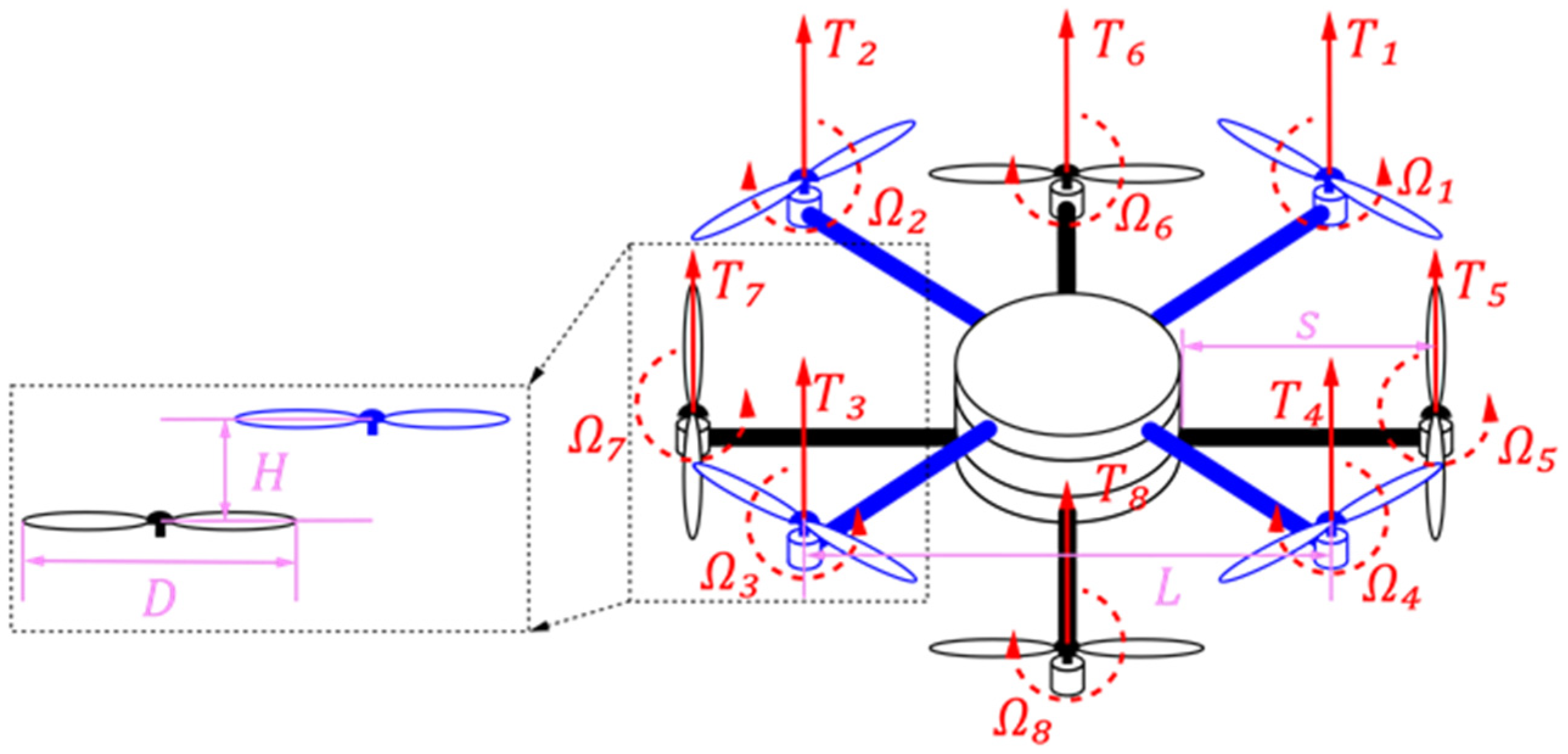


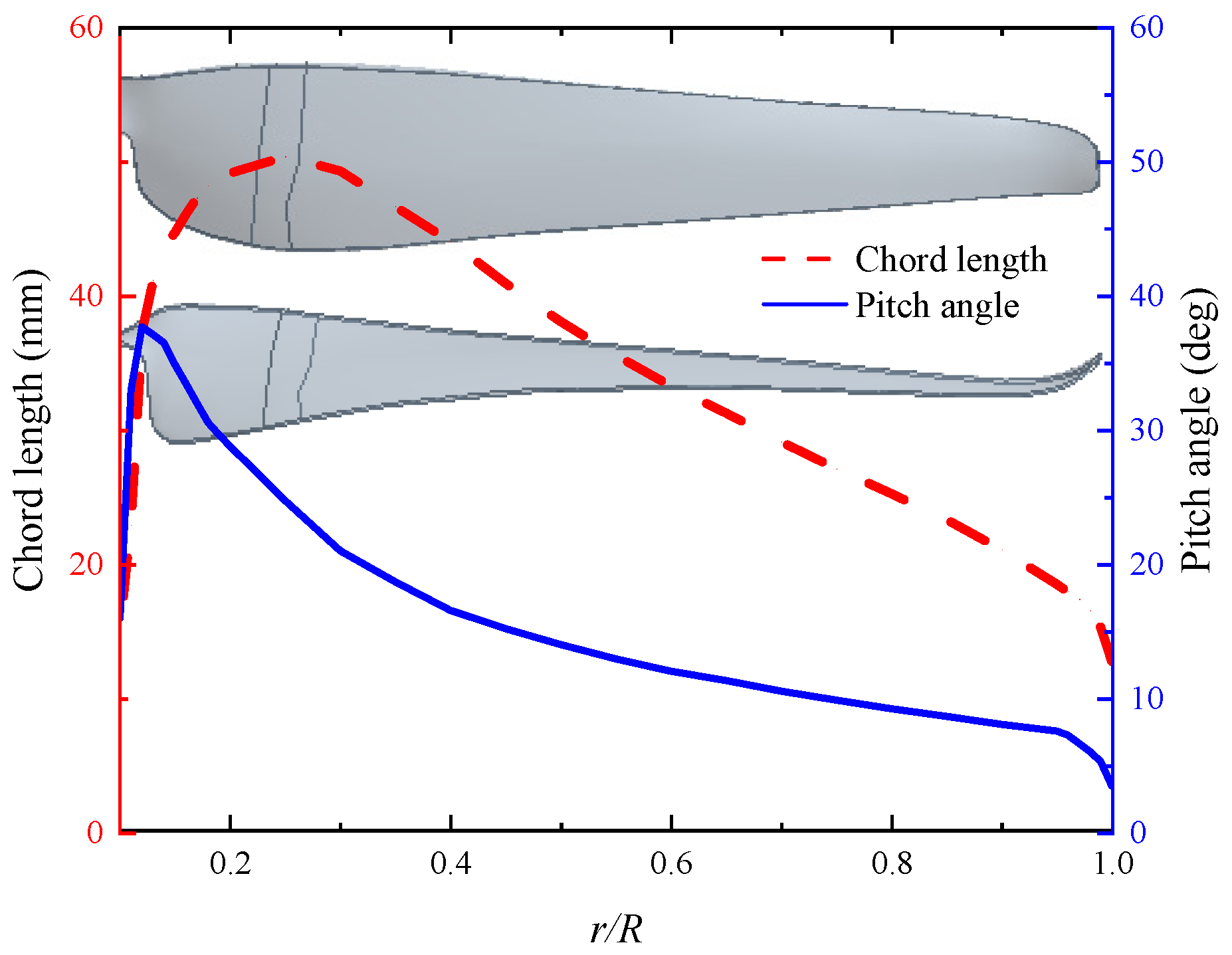

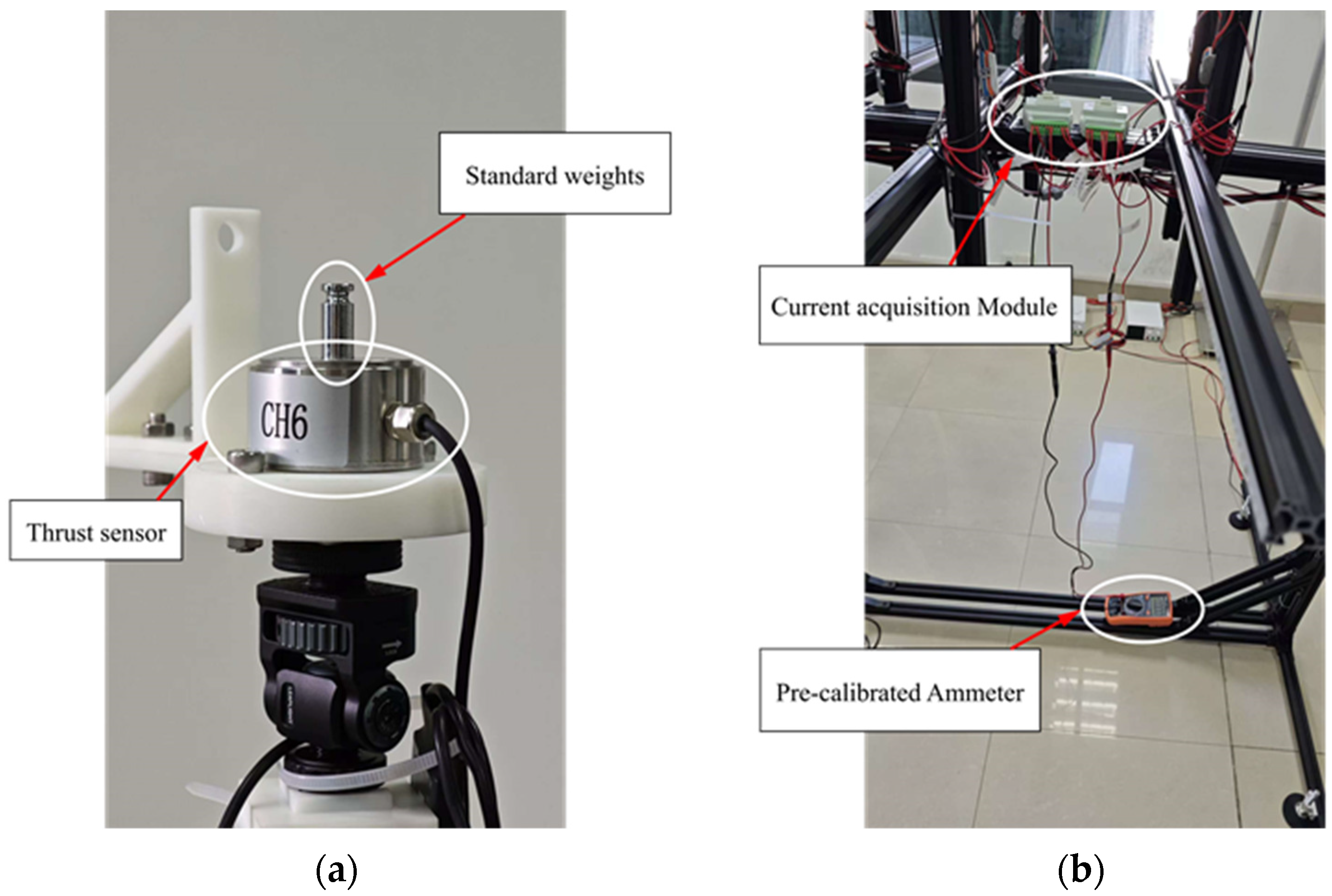
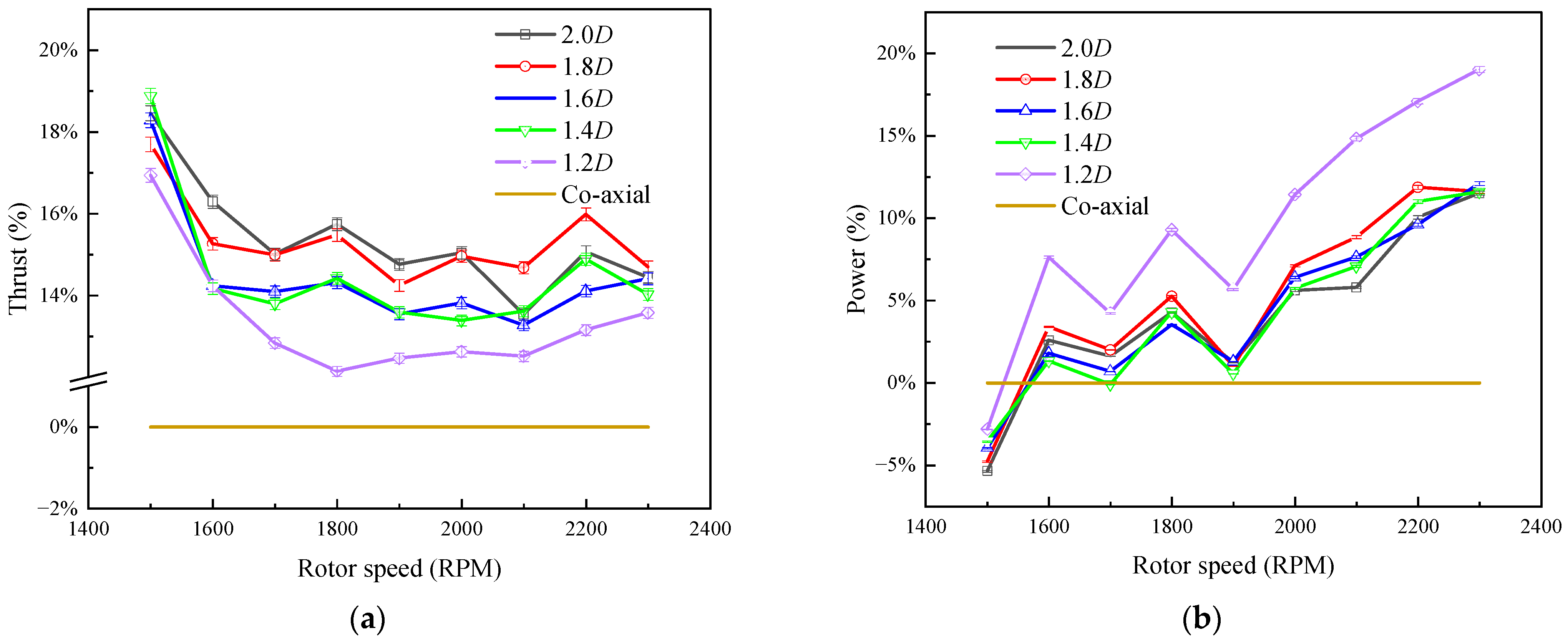
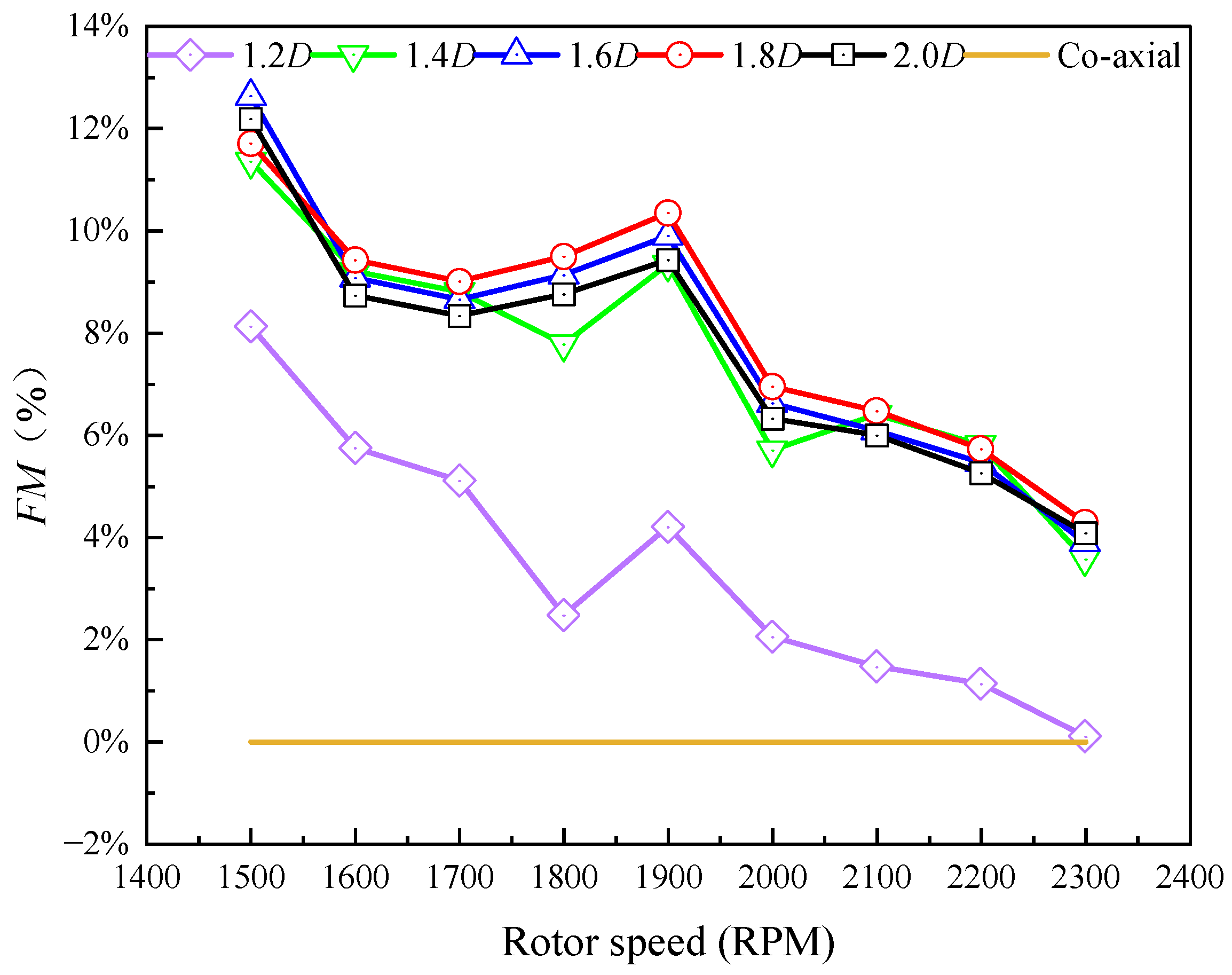

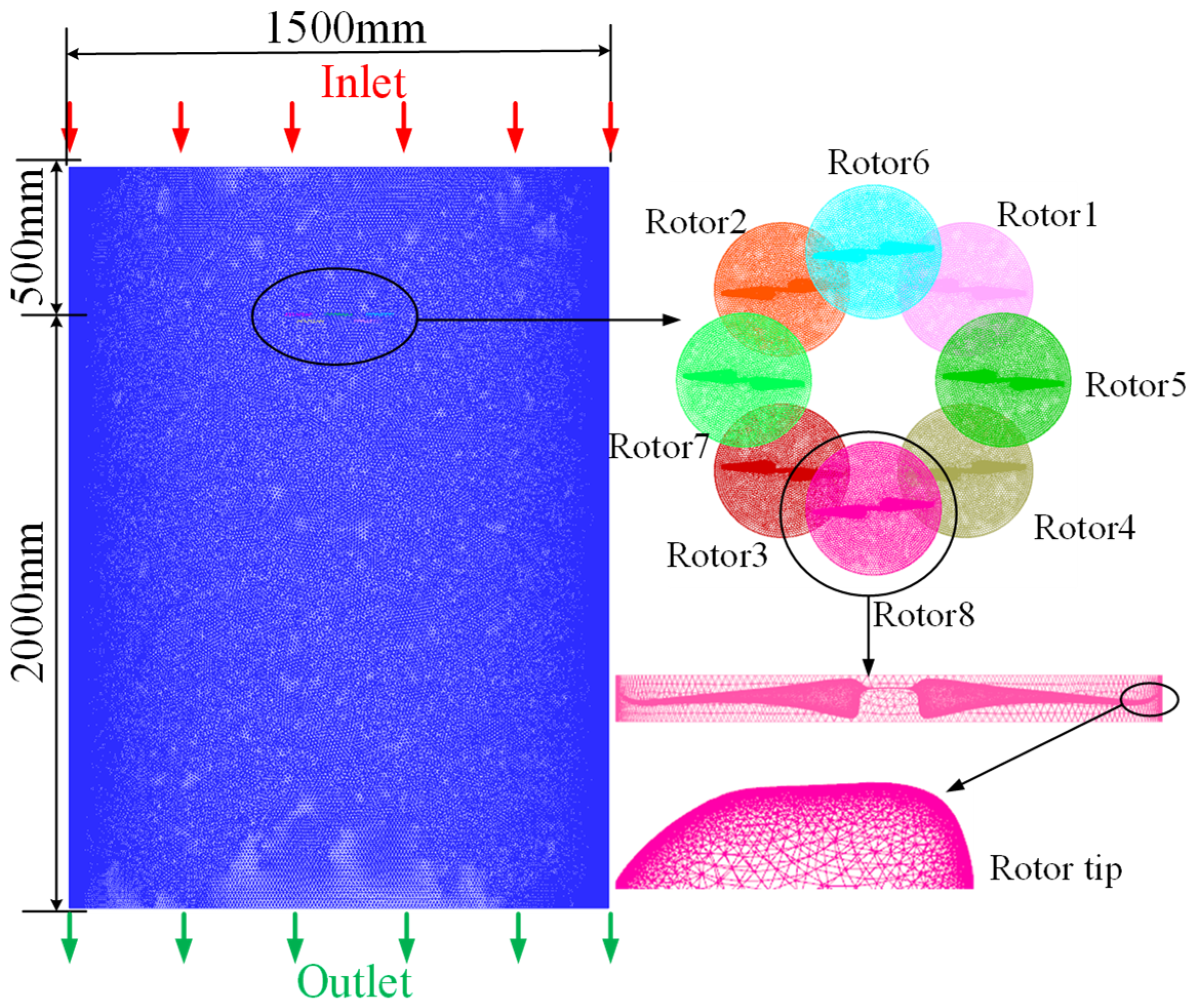

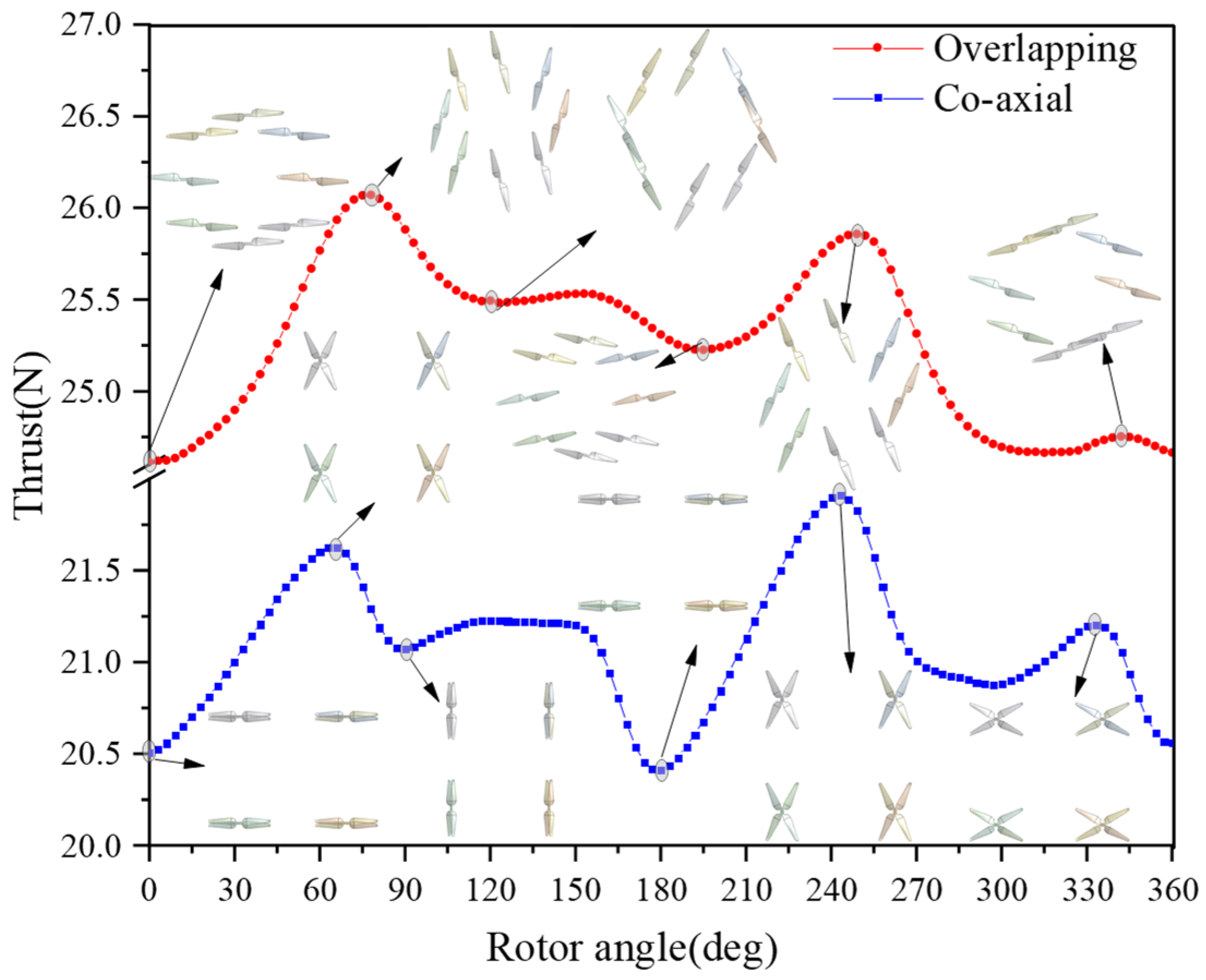

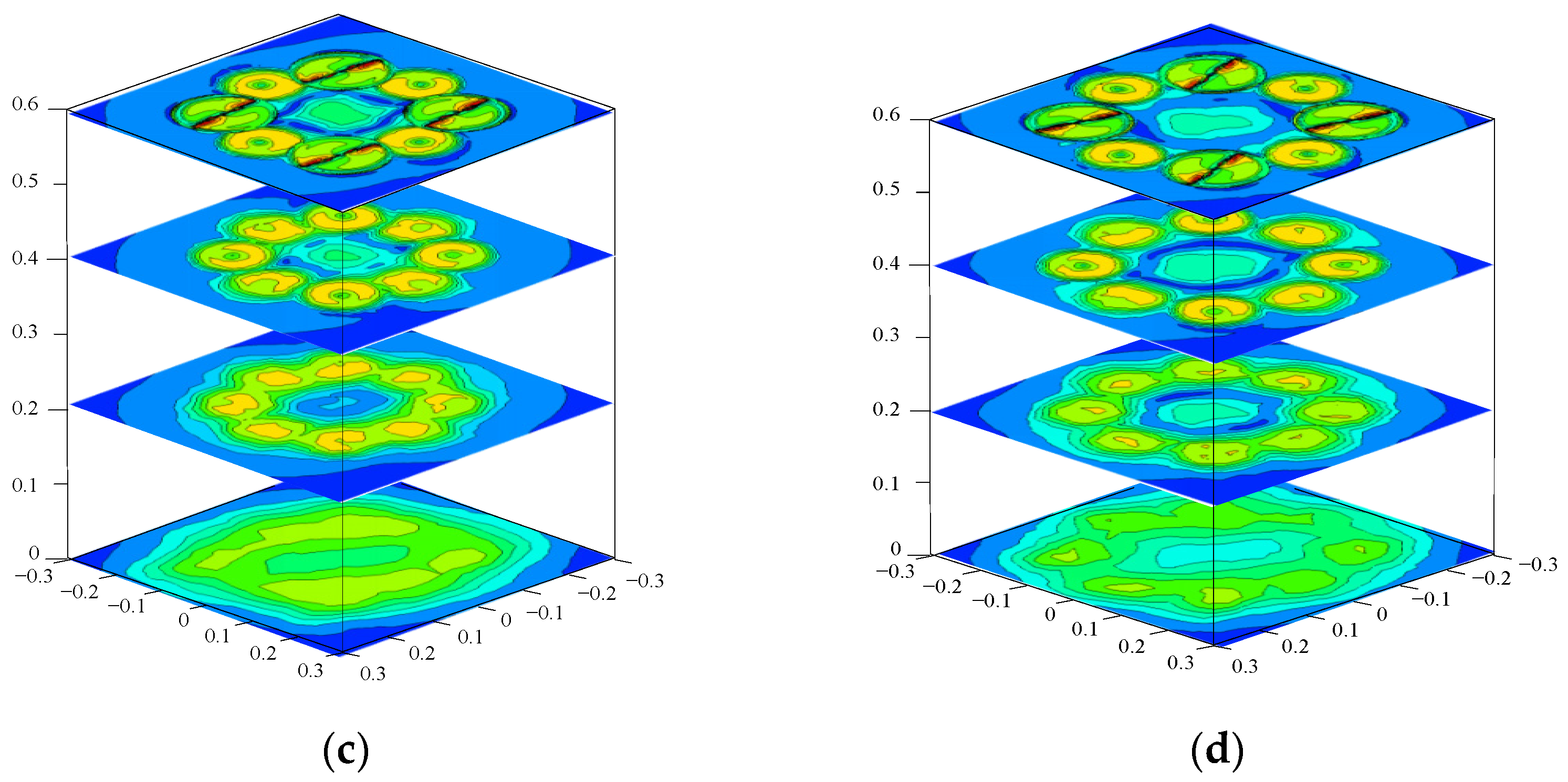

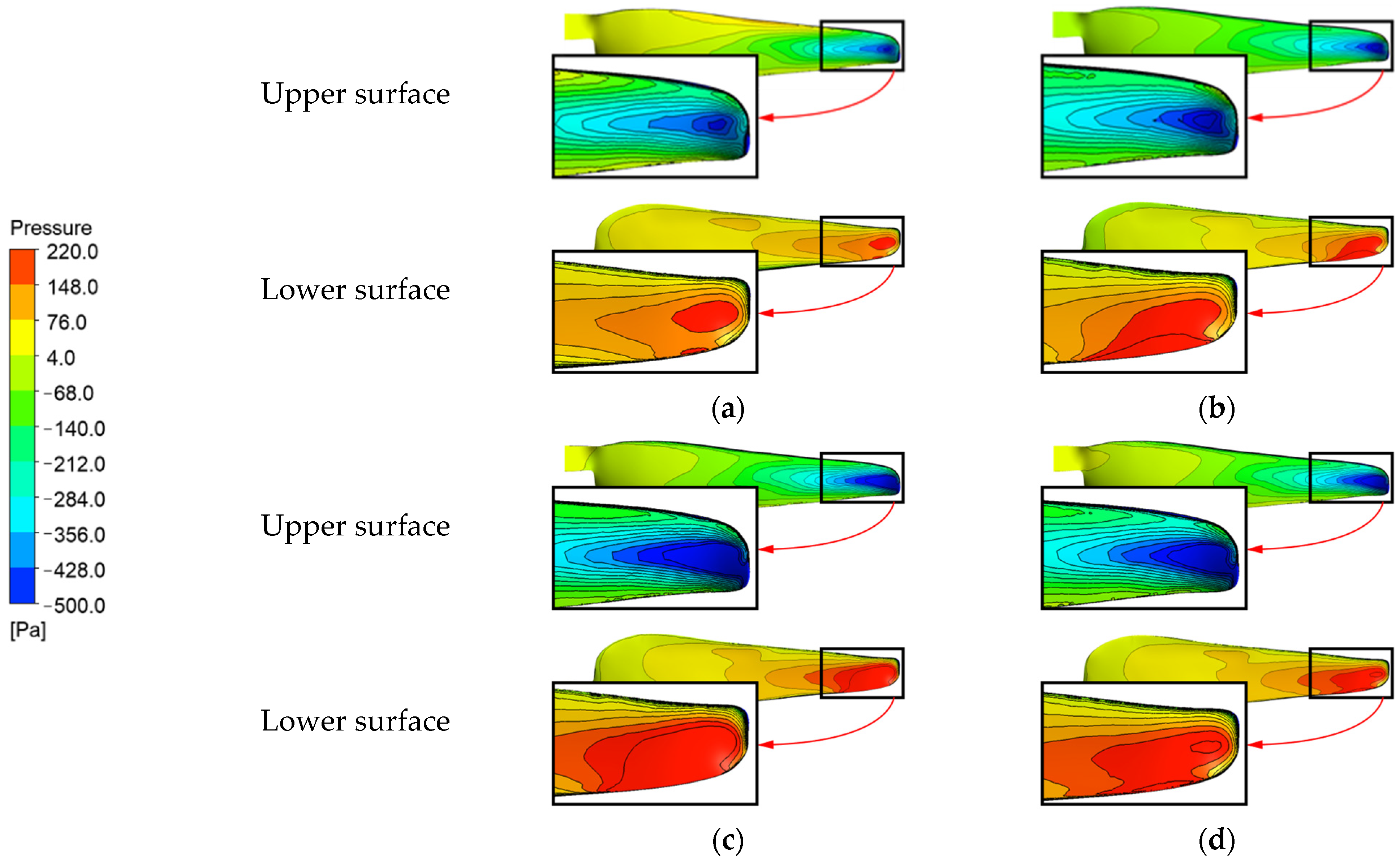
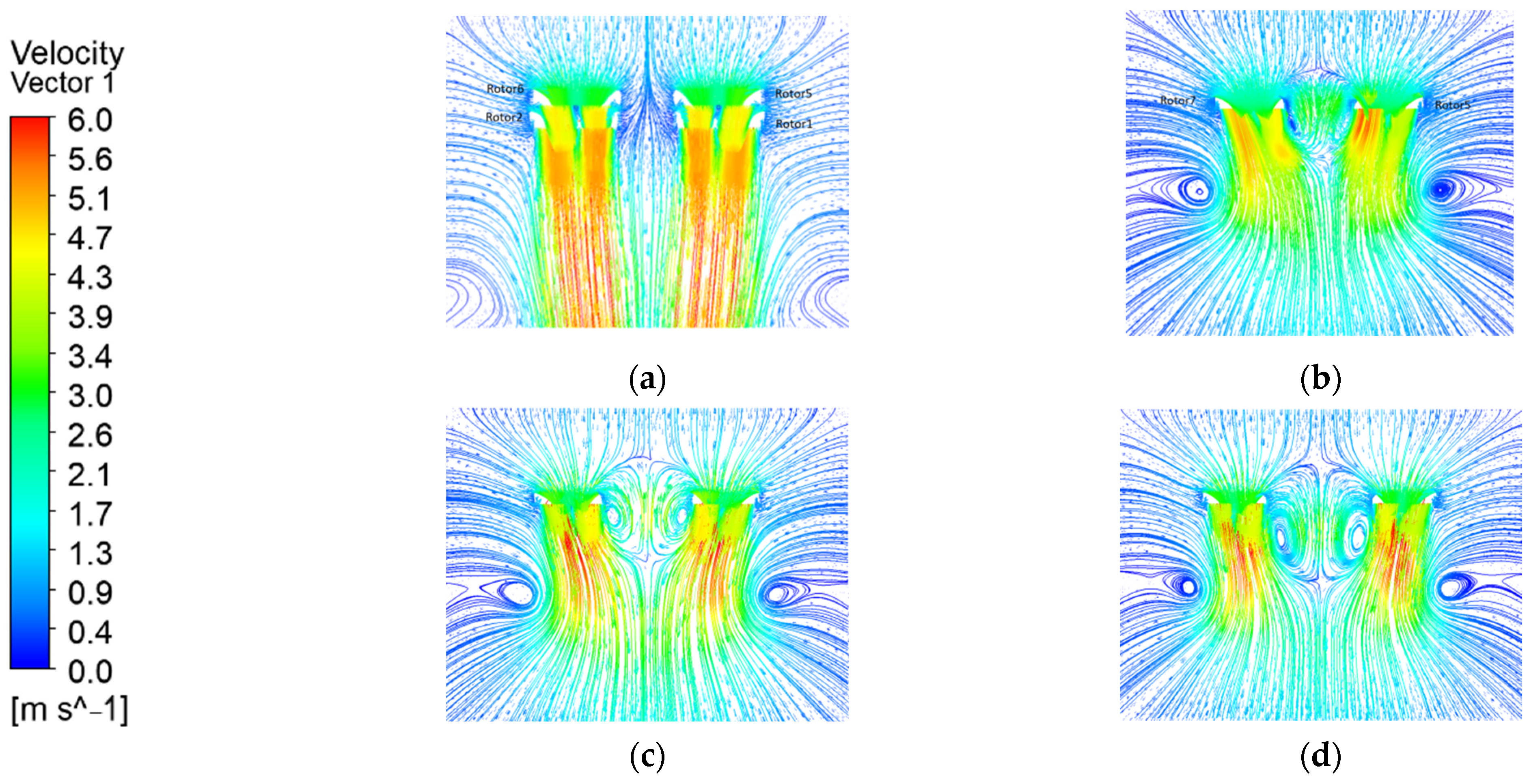
| Parameter | Value |
|---|---|
| Diameter | 400 mm |
| Weight | 0.015 kg |
| Material | Carbon fiber |
| Number of blades | 2 |
| Chord length (75%) | 0.028 m |
| Rotor speed | 1500–2300 RPM |
| Reynolds number (75%R) | |
| Rotor solidity | 0.128 |
| Twist | 0 |
| Tip Mach number | 0.1~0.15 |
| Octocopter | (10−3) | (10−3) | |
|---|---|---|---|
| Co-axial | 12.9574 | 1.5080 | 0.6916 |
| Overlapping 1.2 | 14.5254 | 1.6672 | 0.7425 |
| Overlapping 1.4 | 14.8203 | 1.6445 | 0.7758 |
| Overlapping 1.6 | 14.8066 | 1.6350 | 0.7792 |
| Overlapping 1.8 | 14.9918 | 1.6503 | 0.7865 |
| Overlapping 2.0 | 14.9575 | 1.6489 | 0.7845 |
Disclaimer/Publisher’s Note: The statements, opinions and data contained in all publications are solely those of the individual author(s) and contributor(s) and not of MDPI and/or the editor(s). MDPI and/or the editor(s) disclaim responsibility for any injury to people or property resulting from any ideas, methods, instructions or products referred to in the content. |
© 2024 by the authors. Licensee MDPI, Basel, Switzerland. This article is an open access article distributed under the terms and conditions of the Creative Commons Attribution (CC BY) license (https://creativecommons.org/licenses/by/4.0/).
Share and Cite
Lei, Y.; Zhao, X. The Aerodynamic Performance of a Novel Overlapping Octocopter in Hover. Aerospace 2024, 11, 737. https://doi.org/10.3390/aerospace11090737
Lei Y, Zhao X. The Aerodynamic Performance of a Novel Overlapping Octocopter in Hover. Aerospace. 2024; 11(9):737. https://doi.org/10.3390/aerospace11090737
Chicago/Turabian StyleLei, Yao, and Xiangzheng Zhao. 2024. "The Aerodynamic Performance of a Novel Overlapping Octocopter in Hover" Aerospace 11, no. 9: 737. https://doi.org/10.3390/aerospace11090737






